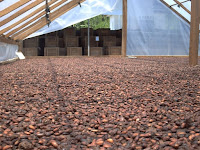Apart from the savory delight experienced by consuming chocolate; here are some Medicinal benefits of cocoa:-
 1. Promotes cardio-vascular health :cocoa as a plant and chocolate as food contain a series of chemicals that can interact with cell and tissue components providing protection against the development and amelioration of pathological conditions.
1. Promotes cardio-vascular health :cocoa as a plant and chocolate as food contain a series of chemicals that can interact with cell and tissue components providing protection against the development and amelioration of pathological conditions.2. Reduction in LDL Cholesterol and increased in HDL cholesterol : according to the European Food Information Council (EUFIC) "Eating cocoa could help reduce LDL ‘bad’ cholesterol, according to a Japanese intervention study, where blood levels of LDL cholesterol decreased significantly compared with levels seen at the beginning of the study, while levels of ‘good’ HDL cholesterol rose."
3. Anti- depressant and europhic effect: cocoa contains the substance phenethylamine, which is a neurotransmitter found in the brain that acts as a mood elevator and natural antidepressant.
 4. Brain Booster- Harvard says that a compound called cocoa flavanols have been recently linked to improved thinking skills.http://www.health.harvard.edu/blog/cocoa-sweet-treat-brain-201502057676
4. Brain Booster- Harvard says that a compound called cocoa flavanols have been recently linked to improved thinking skills.http://www.health.harvard.edu/blog/cocoa-sweet-treat-brain-201502057676 5. Health benefits for women: heart health, sexual health, skin protection and flavanoids.
5. Health benefits for women: heart health, sexual health, skin protection and flavanoids.






